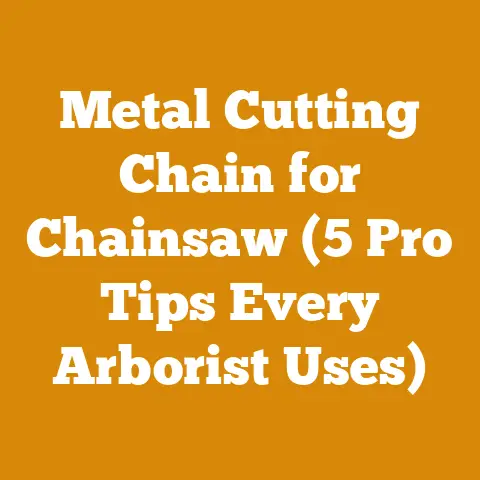DIY Chainsaw Holder Ideas (Tractor Mounting Tips for Woodworkers)
Have you ever felt that surge of frustration when, deep in the woods, your trusty chainsaw is nowhere to be found? Or worse, precariously balanced on a log, just waiting to take a tumble? I’ve been there, more times than I care to admit. That’s why I started exploring DIY chainsaw holders, especially ones that could be mounted on my tractor. It wasn’t just about convenience; it was about safety, efficiency, and protecting my investment in good tools. And the idea of mounting it to my tractor? Genius.
DIY Chainsaw Holder Ideas (Tractor Mounting Tips for Woodworkers)
The Quest for the Perfect Chainsaw Holder
For years, I struggled with the same problem: where to safely and conveniently store my chainsaw while working in the woods. Leaning it against a tree was never a good idea – it was a tripping hazard and exposed the chainsaw to dirt and potential damage. Throwing it in the back of the tractor was even worse, leading to rattling, potential fuel leaks, and the constant worry of damaging the saw.
That’s when I started experimenting with DIY chainsaw holders. My initial attempts were… less than stellar. They were either too flimsy, too bulky, or just plain awkward. But through trial and error, I refined my designs, and I’m excited to share what I’ve learned.
Why Tractor Mounting?
Why focus on tractor mounting? Simple: tractors are the workhorses of wood processing. They’re our mobile workshops, allowing us to move logs, split wood, and navigate challenging terrain. Having a secure chainsaw holder directly on the tractor makes the chainsaw readily accessible, saves time, and minimizes the risk of accidents.
Design Ideas for DIY Chainsaw Holders
Before we dive into the metrics, let’s explore some design ideas. These are based on my own experiences and observations, with a focus on practicality and ease of construction.
-
The Simple Bracket: This is the easiest design to implement. It involves welding or bolting a sturdy metal bracket to the tractor frame or ROPS (Roll Over Protection Structure). The bracket should be shaped to securely hold the chainsaw bar and body.
- Pros: Simple, inexpensive, quick to build.
- Cons: May not offer the best protection against the elements, requires some welding skills (or a friend who welds).
-
The Enclosed Holder: This design provides better protection for the chainsaw. It involves building a box-like structure with a hinged lid. The chainsaw sits inside the box, protected from rain, snow, and debris.
- Pros: Excellent protection, can be easily locked for security.
- Cons: More complex to build, requires more materials.
-
The Quick-Release Holder: This is my personal favorite. It combines the simplicity of the bracket with the security of the enclosed holder. It uses a clamp or latch mechanism to quickly secure and release the chainsaw.
- Pros: Fast and easy access, good protection, relatively simple to build.
- Cons: Requires careful design to ensure a secure fit.
Tractor Mounting Tips
Mounting your chainsaw holder to your tractor requires careful consideration. Here are some tips to keep in mind:
- Choose a Safe Location: Mount the holder in a location that doesn’t obstruct your view or interfere with the tractor’s controls. Avoid mounting it near exhaust pipes or other hot surfaces.
- Use Sturdy Hardware: Use high-quality bolts, nuts, and washers to ensure a secure attachment. Consider using lock washers or thread locker to prevent loosening due to vibration.
- Reinforce the Mounting Point: If you’re mounting the holder to a thin section of the tractor frame, reinforce the area with a backing plate to prevent cracking or bending.
- Consider Vibration: Tractors vibrate a lot. Use rubber washers or vibration-dampening mounts to minimize wear and tear on the chainsaw and the holder.
- Accessibility: Ensure the chainsaw is easily accessible when you need it. You don’t want to be fumbling around in a difficult-to-reach location when you need to make a quick cut.
Project Metrics and KPIs for Wood Processing and Firewood Preparation
Now, let’s move on to the crucial aspect of tracking project metrics. A secure chainsaw holder is just the starting point. To truly optimize your wood processing or firewood preparation operation, you need to understand and track key performance indicators (KPIs). I’ve learned over the years that just doing the work isn’t enough. You need to measure, analyze, and improve.
Why is tracking these metrics important? Because it allows you to:
- Identify Inefficiencies: Pinpoint areas where you’re wasting time, money, or resources.
- Optimize Processes: Refine your methods to improve productivity and reduce costs.
- Make Informed Decisions: Base your decisions on data, not gut feeling.
- Increase Profitability: Ultimately, improve your bottom line.
Here are some key metrics that I track in my own firewood operation, and how you can implement them:
-
Wood Volume Yield Efficiency (WVYE)
- Definition: The percentage of usable wood obtained from a given volume of raw logs.
- Why It’s Important: High WVYE means less waste and more profit from each log. It reflects the efficiency of your bucking and splitting processes.
- How to Interpret It: A low WVYE indicates that you’re either leaving too much wood behind, making poor cuts, or experiencing excessive splitting losses.
- How It Relates to Other Metrics: WVYE is directly related to Wood Waste Percentage (see below) and indirectly related to Time per Cord (as increased efficiency frees up time).
- Practical Example: I once noticed my WVYE was down significantly. After analyzing my process, I realized my chainsaw chain was dull, leading to wider kerf and more sawdust waste. Sharpening my chain immediately improved my WVYE.
- Data Point: Let’s say you start with 10 cubic meters of logs and end up with 7 cubic meters of usable firewood. Your WVYE is (7/10) * 100 = 70%. Aim for 80% or higher.
-
Wood Waste Percentage (WWP)
- Definition: The percentage of wood that is discarded as unusable due to rot, knots, improper cuts, or other factors.
- Why It’s Important: High WWP directly reduces your profit margin. It highlights areas where you need to improve your bucking techniques or log sourcing.
- How to Interpret It: A high WWP suggests you might be accepting logs of poor quality, making inefficient cuts, or not properly utilizing smaller pieces.
- How It Relates to Other Metrics: Directly linked to WVYE (WWP + WVYE should ideally equal 100%), and indirectly related to Cost per Cord (as waste increases your material costs).
- Practical Example: I had a batch of logs that were significantly cheaper than my usual source. However, I quickly discovered that they had a much higher percentage of rot. While the initial price was appealing, the increased WWP made them a poor value overall.
- Data Point: If you start with 10 cubic meters of logs and discard 3 cubic meters as waste, your WWP is (3/10) * 100 = 30%. Aim for 10% or lower.
-
Time per Cord (TPC)
- Definition: The amount of time it takes to process one cord of firewood from raw logs to split and stacked wood.
- Why It’s Important: TPC is a direct measure of your productivity. Reducing TPC increases the amount of firewood you can produce in a given timeframe.
- How to Interpret It: A high TPC indicates inefficiencies in your process, such as slow equipment, poor workflow, or unnecessary steps.
- How It Relates to Other Metrics: Closely related to Equipment Downtime (as downtime increases TPC), and also influenced by WVYE (as less waste means less time spent processing unusable wood).
- Practical Example: I invested in a new hydraulic log splitter and saw my TPC decrease by 25%. The faster splitting speed significantly increased my overall productivity.
- Data Point: If it takes you 8 hours to process one cord of firewood, your TPC is 8 hours/cord. Aim for 4-6 hours/cord, depending on the size and type of wood.
-
Cost per Cord (CPC)
- Definition: The total cost (including materials, labor, equipment, and overhead) required to produce one cord of firewood.
- Why It’s Important: CPC determines your profitability. Understanding your CPC allows you to price your firewood competitively while still making a profit.
- How to Interpret It: A high CPC can indicate excessive spending on materials, inefficient labor practices, or high equipment costs.
- How It Relates to Other Metrics: Influenced by all other metrics, including WVYE, TPC, Equipment Downtime, and Fuel Consumption. Reducing waste, improving efficiency, and minimizing downtime all contribute to a lower CPC.
- Practical Example: By switching to a more fuel-efficient chainsaw and optimizing my bucking process, I was able to reduce my CPC by 10%.
- Data Point: If your total costs to produce 10 cords of firewood are $800, your CPC is $80/cord. Aim to keep your CPC below your selling price.
-
Equipment Downtime (ED)
- Definition: The amount of time equipment is out of service due to repairs, maintenance, or breakdowns.
- Why It’s Important: ED directly impacts your productivity and profitability. Minimizing downtime ensures that your equipment is always ready when you need it.
- How to Interpret It: High ED suggests that you’re not properly maintaining your equipment, or that you’re using unreliable tools.
- How It Relates to Other Metrics: Directly related to TPC (as downtime increases TPC), and also influences CPC (as downtime can lead to increased labor costs).
- Practical Example: I started implementing a regular maintenance schedule for my chainsaw and log splitter, including sharpening the chain, cleaning the air filter, and lubricating moving parts. This significantly reduced my ED.
- Data Point: If your chainsaw is out of service for 2 hours per week, your ED is 2 hours/week. Aim to keep your ED below 1 hour/week.
-
Fuel Consumption (FC)
- Definition: The amount of fuel consumed per cord of firewood processed, or per hour of equipment operation.
- Why It’s Important: FC is a significant operating expense. Reducing fuel consumption can save you money and reduce your environmental impact.
- How to Interpret It: High FC suggests that you’re using inefficient equipment, or that you’re not operating your equipment optimally.
- How It Relates to Other Metrics: Influences CPC (as fuel costs are a component of CPC), and can be indirectly related to TPC (as more efficient equipment can reduce TPC).
- Practical Example: I switched to a higher-quality chainsaw oil and noticed a slight improvement in fuel efficiency. Over time, this small change added up to significant savings.
- Data Point: If you use 5 gallons of fuel to process one cord of firewood, your FC is 5 gallons/cord. Aim to reduce your FC by using fuel-efficient equipment and optimizing your operating techniques.
-
Moisture Content (MC)
- Definition: The percentage of water in the firewood.
- Why It’s Important: MC directly affects the burn quality and heat output of the firewood. Properly seasoned firewood (low MC) burns hotter and cleaner.
- How to Interpret It: High MC indicates that the firewood is not properly seasoned and will be difficult to burn.
- How It Relates to Other Metrics: Influences customer satisfaction and repeat business. Selling firewood with low MC ensures that your customers are happy with your product.
- Practical Example: I invested in a moisture meter to accurately measure the MC of my firewood. This allowed me to guarantee that my customers were getting properly seasoned wood.
- Data Point: Firewood with an MC of 20% or less is considered properly seasoned. Aim to achieve an MC of 15-20% before selling your firewood.
-
Sales Price per Cord (SPC)
- Definition: The price at which you sell one cord of firewood.
- Why It’s Important: SPC, combined with CPC, determines your profit margin.
- How to Interpret It: Your SPC should be high enough to cover your CPC and provide a reasonable profit.
- How It Relates to Other Metrics: Directly related to CPC (as profit margin = SPC – CPC).
- Practical Example: I researched the local market prices for firewood and adjusted my SPC accordingly. I also offered different grades of firewood (based on MC and wood type) at different price points.
- Data Point: If your CPC is $80/cord and you sell your firewood for $120/cord, your profit margin is $40/cord.
-
Customer Acquisition Cost (CAC)
- Definition: The cost of acquiring a new customer. This includes marketing expenses, advertising costs, and any other expenses associated with attracting new business.
- Why It’s Important: Understanding your CAC helps you to optimize your marketing efforts and ensure that you’re not spending too much to acquire new customers.
- How to Interpret It: A high CAC suggests that your marketing efforts are not effective, or that you’re targeting the wrong audience.
- How It Relates to Other Metrics: Influences overall profitability. Reducing your CAC allows you to increase your profit margin.
- Practical Example: I experimented with different marketing channels, including online advertising, flyers, and word-of-mouth referrals. By tracking the cost of each channel and the number of customers it generated, I was able to identify the most cost-effective marketing strategies.
- Data Point: If you spend $100 on advertising and acquire 10 new customers, your CAC is $10/customer.
-
Customer Retention Rate (CRR)
- Definition: The percentage of customers who return to purchase firewood from you again.
- Why It’s Important: Retaining existing customers is much cheaper than acquiring new ones. A high CRR indicates that your customers are satisfied with your product and service.
- How to Interpret It: A low CRR suggests that you need to improve your customer service, product quality, or pricing.
- How It Relates to Other Metrics: Influences long-term profitability. Retaining customers allows you to build a loyal customer base and generate recurring revenue.
- Practical Example: I implemented a loyalty program to reward repeat customers. I also made a point of providing excellent customer service and addressing any complaints promptly.
- Data Point: If you start with 100 customers and retain 80 of them over a year, your CRR is 80%.
Challenges Faced by Small-Scale Loggers and Firewood Suppliers Worldwide
I understand that not everyone has access to the same resources or equipment. Small-scale loggers and firewood suppliers around the world often face unique challenges, such as:
- Limited Access to Capital: Difficulty obtaining loans or grants to invest in new equipment or improve their operations.
- Lack of Training and Education: Limited access to training programs on sustainable forestry practices, equipment maintenance, and business management.
- Fluctuating Market Prices: Exposure to volatile market prices for firewood, which can make it difficult to plan and budget.
- Environmental Regulations: Navigating complex environmental regulations related to logging and firewood harvesting.
- Competition from Larger Operations: Competing with larger, more established firewood suppliers who have economies of scale.
Despite these challenges, small-scale loggers and firewood suppliers play a vital role in their communities. They provide a valuable source of fuel, create jobs, and help to manage forests sustainably. By focusing on efficiency, quality, and customer service, they can overcome these challenges and thrive in a competitive market.
Applying These Metrics to Improve Future Projects
The key to success in wood processing and firewood preparation is continuous improvement. By tracking these metrics, analyzing the data, and implementing changes based on your findings, you can consistently improve your efficiency, reduce your costs, and increase your profitability.
Here are some steps you can take to apply these metrics to your future projects:
- Start Tracking: Choose a few key metrics to track initially. Don’t try to track everything at once. Start with the metrics that are most important to your business goals.
- Use a Spreadsheet or Software: Use a spreadsheet program like Excel or Google Sheets to record your data. There are also specialized software programs available for managing forestry operations.
- Analyze the Data: Regularly review your data to identify trends and patterns. Look for areas where you’re excelling and areas where you need to improve.
- Implement Changes: Based on your analysis, implement changes to your processes, equipment, or marketing strategies.
- Monitor the Results: Track the results of your changes to see if they’re having the desired effect.
- Adjust as Needed: Be prepared to adjust your approach as needed. The key is to be flexible and adaptable.
The Chainsaw Holder: A Symbol of Efficiency
Ultimately, building a DIY chainsaw holder is more than just a fun project. It’s a symbol of efficiency, organization, and a commitment to doing things the right way. And by tracking the metrics I’ve outlined, you can extend that commitment to every aspect of your wood processing or firewood preparation operation.
Remember, the journey to a more efficient and profitable operation is a continuous one. Embrace the process of learning, experimenting, and improving. And don’t be afraid to share your experiences with others. Together, we can build a more sustainable and prosperous future for the wood industry. Happy woodworking!






